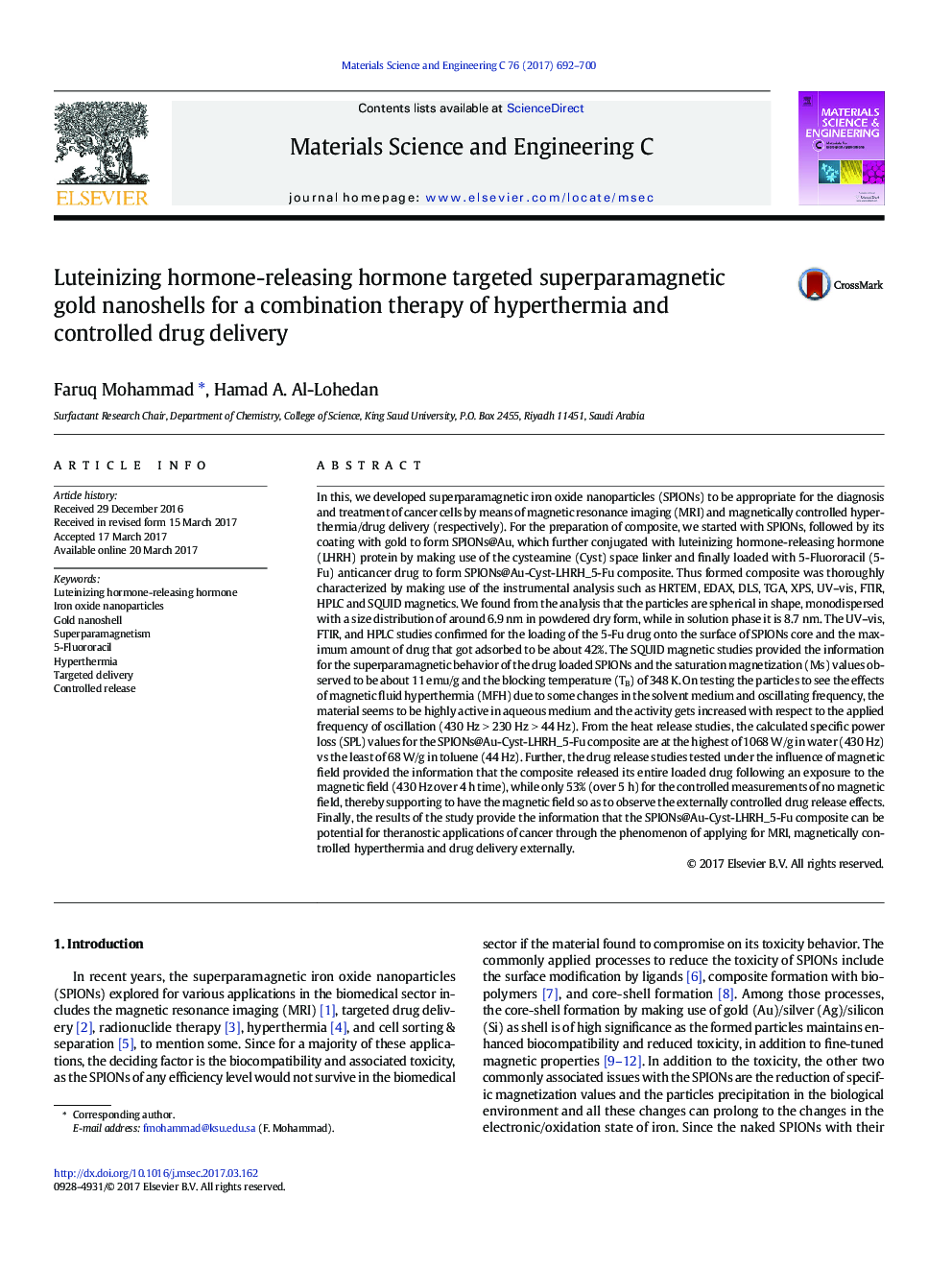| کد مقاله | کد نشریه | سال انتشار | مقاله انگلیسی | نسخه تمام متن |
|---|---|---|---|---|
| 5435163 | 1509145 | 2017 | 9 صفحه PDF | دانلود رایگان |
- The approach describes the combination of hyperthermia and drug delivery applicable for non-invasive cancer treatment.
- Developed a simple method for conjugating iron oxide nanoparticles to LHRH protein by the use of Cysteamine space linker.
- Loading capacity and externally controlled drug release effects of 5-Fluororacil and targeted SPIONs were studied.
- For the first time we used SPIONs with targeting capacity for the delivery of therapeutic heat and drug to cancer cells.
- The approach allows for the externally controlled delivery of heat and drug to cancer cells with LHRH receptors.
In this, we developed superparamagnetic iron oxide nanoparticles (SPIONs) to be appropriate for the diagnosis and treatment of cancer cells by means of magnetic resonance imaging (MRI) and magnetically controlled hyperthermia/drug delivery (respectively). For the preparation of composite, we started with SPIONs, followed by its coating with gold to form SPIONs@Au, which further conjugated with luteinizing hormone-releasing hormone (LHRH) protein by making use of the cysteamine (Cyst) space linker and finally loaded with 5-Fluororacil (5-Fu) anticancer drug to form SPIONs@Au-Cyst-LHRH_5-Fu composite. Thus formed composite was thoroughly characterized by making use of the instrumental analysis such as HRTEM, EDAX, DLS, TGA, XPS, UV-vis, FTIR, HPLC and SQUID magnetics. We found from the analysis that the particles are spherical in shape, monodispersed with a size distribution of around 6.9 nm in powdered dry form, while in solution phase it is 8.7 nm. The UV-vis, FTIR, and HPLC studies confirmed for the loading of the 5-Fu drug onto the surface of SPIONs core and the maximum amount of drug that got adsorbed to be about 42%. The SQUID magnetic studies provided the information for the superparamagnetic behavior of the drug loaded SPIONs and the saturation magnetization (Ms) values observed to be about 11 emu/g and the blocking temperature (TB) of 348 K. On testing the particles to see the effects of magnetic fluid hyperthermia (MFH) due to some changes in the solvent medium and oscillating frequency, the material seems to be highly active in aqueous medium and the activity gets increased with respect to the applied frequency of oscillation (430 Hz > 230 Hz > 44 Hz). From the heat release studies, the calculated specific power loss (SPL) values for the SPIONs@Au-Cyst-LHRH_5-Fu composite are at the highest of 1068 W/g in water (430 Hz) vs the least of 68 W/g in toluene (44 Hz). Further, the drug release studies tested under the influence of magnetic field provided the information that the composite released its entire loaded drug following an exposure to the magnetic field (430 Hz over 4 h time), while only 53% (over 5 h) for the controlled measurements of no magnetic field, thereby supporting to have the magnetic field so as to observe the externally controlled drug release effects. Finally, the results of the study provide the information that the SPIONs@Au-Cyst-LHRH_5-Fu composite can be potential for theranostic applications of cancer through the phenomenon of applying for MRI, magnetically controlled hyperthermia and drug delivery externally.
74
Journal: Materials Science and Engineering: C - Volume 76, 1 July 2017, Pages 692-700
